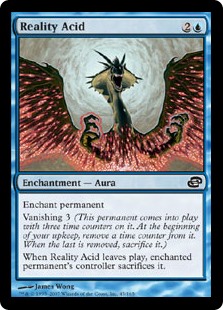Blue has a reputation. Depending on your point of view, this is an unfair expectation, maligned by other players who bemoan a few overpowered cards from 20 years ago that warp some Eternal formats more than other colors as indicative of being perennially more powerful than the rest – as if a Counterspell was the bane for every game they ever lost. Others see their angst as justified, as Blue is the color of control, a color whose very nature revolves around deflecting and denying what their opponent is trying to do, and this can be beyond frustrating to some people. Mostly because a majority of us don’t like being told no to something they want to do.
It’s that little part of us that remains four years old forever.
Whatever the case may be, three truths do emerge about the color of water, illusion, and denial. First, it’s far from infallible. Blue has numerous weaknesses that are strangely either glossed over or so taken for granted that people don’t even realize are weaknesses. Second, that fact is not going to stop people from complaining about the perception of unfairness – 25 years of cultural precedent is a hard thing to break. And finally, despite its near-monopoly on counters and bouncing, there are plenty of card effects it almost never gets.
Sometimes, though, a strange one does sneak through that does something nonblue in a very Blue way. And that brings us to today.
Chances are this Monday I’ll still be recovering from attending yet another board game convention, which will likely leave me feeling a bit exhausted heading back to work. I wouldn’t even be surprised if I were to keep a low profile that day to recover, to disappear from the online arena as it were, as is something I tend to do the day after conventions. At least for a little while.
Coincidentally, that same idea of retreating a bit from the world as a result of time spent elsewhere ties perfectly into this week’s card pick.
Today we have: Reality Acid

Name: Reality Acid
Edition: Planar Chaos
Rarity: Common
Focus: Permanent Destruction
Highlights: Reality Acid is one of the many Time Spiral era cards that paid homage to, or specifically brought back, other mechanics from Magic’s past. In this case it was Vanishing, a slightly revamped iteration of Fading used in the Time Spiral block that fixed some corner case abuse issues of Fading while tying into the block’s “time theme”. One thing that didn’t change much, however, was that reception to Vanishing was only modestly better than Fading. People enjoyed it more this time around because it was easier to manipulate and there were more standout cards people felt were worth using outside of Limited despite their ephemeral nature. Reality Acid was among them.
Despite its Planar Chaos origins, Reality Acid is a very straightforward Aura. For three mana, you can attach it to any targetable permanent on the battlefield, which comes with three time counters on it. In typical Vanishing fashion, during your upkeep, you remove a time counter from it, and when the last is removed, the card is sacrificed. In the case of Reality Acid, its principal effect kicks in – forcing the controller of the enchanted permanent to sacrifice it as well, taking its bonded target with it back into the aether.
Yes, Reality Acid is an Aura-based, time-delayed spot removal card. And it’s not limited to creatures. Reality Acid can target any permanent on the battlefield, from abusive lands, to problematic enchantments, to potentially dangerous planeswalkers. This versatility and cheap mana cost makes it not only highly efficient, but also much more powerful than it may seem at a mere glance. Especially for a common. Double especially for Blue, which rarely actually gets straight-up destruction cards.
The tradeoff is that its effect is highly telegraphed, which can often be problematic in longer and larger games of EDH, as you’re normally giving your opponents the time to potentially find answers to it, and on the surface, Reality Acid is very much in that category, since it takes three full rounds for all the time counters to be removed.
Yet what makes this card so insidious is the way it’s worded: Reality Acid will trigger as soon as it leaves the battlefield for any reason. This includes being destroyed, bounced, flickered, or exiled. What this means is that with rare exception, Reality Acid will always corrode away its target, and Vanishing’s tie-in only ensures that it will take at most three rounds for it to take effect, as there are numerous ways to force it to happen sooner. Heck, there were even block-centric options at the time that took advantage of this fact. This gives the card even more potency in tandem with other cards, though its effect at removing something from the table should not be overlooked.
Keep an eye out for us to be regularly featuring other more accessible-but-worth-it Commander cards going forward. In the meantime, we’ll keep the light on for you.
![]()
You can discuss this article over on our social media!
